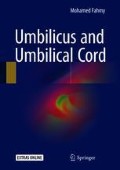Abstract
Ventral body wall defects comprise a group of congenital malformations that includes congenital umbilical cord hernia, gastroschisis and omphalocele, which are relatively common, and ectopia cordis, bladder exstrophy and cloacal exstrophy, which are relatively rare, along with another extremely rare defect which was only present as a case report in literature, such as body stalk anomalies, vesico-intestinal fissure, sternal defect and OEIS syndrome.
Recently, there is an increase in the occurrence of gastroschisis; cases with omphalocele had more syndromic and nonsyndromic anomalies, more chromosomal anomalies, a higher mortality rate and more common with an older mothers. The natural history of omphalocele and gastroschisis covaries with race, black infants with gastroschisis have worse survival outcomes, while those with omphalocele have better chances of survival than their White or Hispanic counterparts. Gastroschisis and omphalocele are the two most common congenital abdominal wall defects; both are frequently detected prenatally. Prognosis for gastroschisis is primarily determined by the degree of bowel injury, whereas prognosis for omphalocele is related to the number and severity of associated anomalies. The surgical management of both conditions consists of closure of the abdominal wall defect while minimizing the risk of injury to the abdominal viscera either through direct trauma or due to increased intra-abdominal pressure. Options include primary closure or a variety of staged approaches. Long-term outcome is favourable in most cases; however, significant associated anomalies (in the case of omphalocele) or intestinal dysfunction (in the case of gastroschisis) may result in morbidity and mortality.
Cases of congenital hernia of the cord are usually unrecognizable or misdiagnosed as an examophalos minor, so this entity discussed separately with special emphasis about the proper diagnosis of the classical cases and their variants.
References
Pare A. The works of that famous Chirurgeon. London: Th. Cotes and R. Young; 1634. p. 59. Book 24.
Hey W. Practical observations in surgery. London: Cadell and Davies; 1803. p. 226.
Hamilton J. In Cooper, A. (1807). The anatomy and surgical treatment of Crural and umbilical hernia, part 2. London: Longman; 1806. p. 56.
Scarpa A. Traite pratique des Hernies. Paris: Gabon; 1812.
Ahifeld F. Der Alkohol bei der Behandlung inoperabeler Bauchbriiche. Mschr Geburtsh Gynak. 1899;10:124.
Dillon PW, Cilley RE. Newborn surgical emergencies. Gastrointestinal anomalies, abdominal wall defects. Pediatr Clin N Am. 1993;40:1289–314.
McNair C, Hawes J, Urquhart H. Caring for the newborn with an omphalocoele. Neonatal Netw. 2006;25(5):319–32. doi:10.1891/0730- 0832.25.5.319.
Quemelo PRV, et al. Teratogenic effect of retinoic acid in swiss mice. Acta Cir Bras. 2007;22(6):451.
Singh S, Madaree A. Omphalocoeles: A decade in review. S Afr J Child Health. 2016;10(4):211–4. doi:10.7196/SAJCH.2016.v10i4.1149.
Salihu HM, et al. Omphalocele and Gastroschisis: black-white disparity in infant survival. Birth Defects Res A. 2004;70:586–91.
Van Eijck FC, Hoogeveen YL, van Weel C, Rieu PN, Wijnen RM. Minor and giant omphalocele: long-term outcomes and quality of life. J Pediatr Surg. 2009;44:1355–9.
Hamid R, Mufti G, Wani SA, Ali I, Bhat NA, et al. Importance of the early management of omphalocele minor. J Neonatal Biol. 2015;4:169. doi:10.4172/2167-0897.1000169.
Mayer T, et al. Gastroschisis and omphalocele, an eight-year review. Ann Surg. 1980;192(6):783–7.
Schwalbe E. Die Morphologie der Missbildungen des Menschen und der Tiere. Jena: Fischer; 1909.
Cantrell JR, Haller JA, Ravitch MM. A syndrome of congenital defects involving the abdominal wall, sternum, diaphragm, pericardium, and heart. Surg Gynecol Obstet. 1958;107(5):602–14.
Groves R, Sunderajan L, Khan AR, et al. Congenital anomalies are commonly associated with exomphalos minor. J Pediatr Surg. 41(2):358–61. doi:10.1016/j.jpedsurg.2005.11.013.
How HY, Harris BJ, Pietrantoni M, Evans JC, Dutton S, Khoury J, et al. Is vaginal delivery preferable to elective cesarean delivery in fetuses with a known ventral wall defect? Am J Obstet Gynecol. 2000;182(6):1527–34. doi:10.1067/mob.2000.106852.
Hamid R, Mufti G, Wani SA, Ali I, Bhat NA, et al. Importance of the early Management of Omphalocele Minor. J Neonatal Biol. 2015;4:169. doi:10.4172/2167-0897.1000169.
Cohen-Overbeek TE, Tong WH, Hatzmann TR, et al. Omphalocele: comparison of outcome following prenatal or postnatal diagnosis. Ultrasound Obstet Gynecol. 2010;36(6):687–92. doi:10.1002/uog.7698.
Wakhlu A, Wakhlu AK. The management of exomphalos. J Pediatr Surg. 2000;35:73–6.
Author information
Authors and Affiliations
Rights and permissions
Copyright information
© 2018 Springer International Publishing AG
About this chapter
Cite this chapter
Fahmy, M. (2018). Examophalos (Omphalocoele). In: Umbilicus and Umbilical Cord. Springer, Cham. https://doi.org/10.1007/978-3-319-62383-2_34
Download citation
DOI: https://doi.org/10.1007/978-3-319-62383-2_34
Published:
Publisher Name: Springer, Cham
Print ISBN: 978-3-319-62382-5
Online ISBN: 978-3-319-62383-2
eBook Packages: MedicineMedicine (R0)

